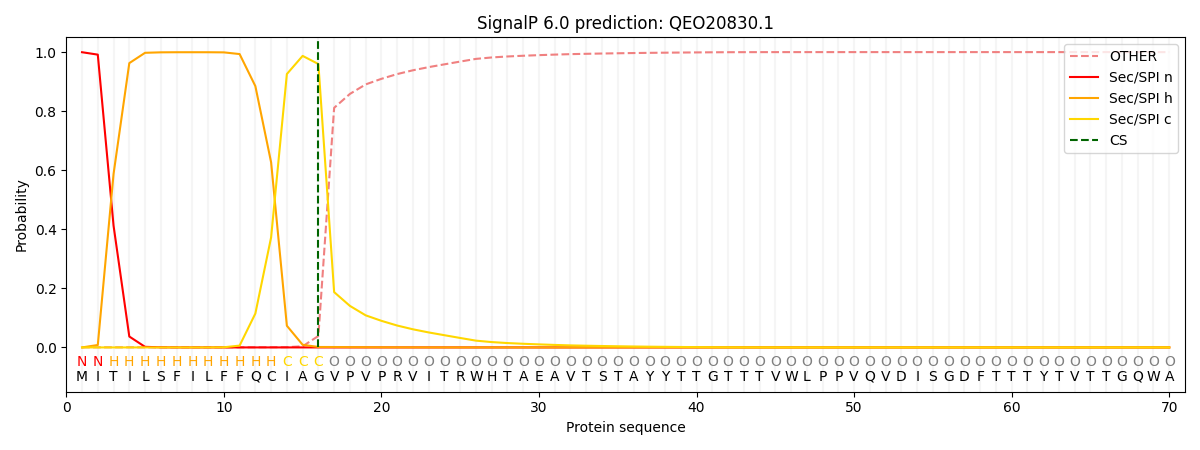You are browsing environment: FUNGIDB
CAZyme Information: QEO20830.1
You are here: Home > Sequence: QEO20830.1
Basic Information |
Genomic context |
Full Sequence |
Enzyme annotations |
CAZy signature domains |
CDD domains |
CAZyme hits |
PDB hits |
Swiss-Prot hits |
SignalP and Lipop annotations |
TMHMM annotations
Basic Information help
| Species | [Candida] auris | |||||||||||
|---|---|---|---|---|---|---|---|---|---|---|---|---|
| Lineage | Ascomycota; Saccharomycetes; ; Debaryomycetaceae; Candida; [Candida] auris | |||||||||||
| CAZyme ID | QEO20830.1 | |||||||||||
| CAZy Family | GH5 | |||||||||||
| CAZyme Description | hypothetical_protein | |||||||||||
| CAZyme Property |
|
|||||||||||
| Genome Property |
|
|||||||||||
| Gene Location | ||||||||||||
CAZyme Signature Domains help
| Family | Start | End | Evalue | family coverage |
|---|---|---|---|---|
| GH17 | 216 | 453 | 1.2e-21 | 0.9163987138263665 |
CDD Domains download full data without filtering help
| Cdd ID | Domain | E-Value | qStart | qEnd | sStart | sEnd | Domain Description |
|---|---|---|---|---|---|---|---|
| 227625 | Scw11 | 2.20e-75 | 188 | 453 | 36 | 301 | Exo-beta-1,3-glucanase, GH17 family [Carbohydrate transport and metabolism]. |
| 236776 | PRK10856 | 5.87e-05 | 67 | 144 | 155 | 231 | cytoskeleton protein RodZ. |
| 381626 | GH113_mannanase-like | 1.20e-04 | 290 | 427 | 127 | 270 | Glycoside hydrolase family 113 beta-1,4-mannanase and similar proteins. Mannan endo-1,4-beta mannosidase (E.C 3.2.1.78) randomly cleaves (1->4)-beta-D-mannosidic linkages in mannans, galactomannans and glucomannans and is also called beta-1,4-mannanase, endo-1,4-beta-mannanase, endo-beta-1,4-mannase, beta-mannanase B, beta-1, 4-mannan 4-mannanohydrolase, endo-beta-mannanase, beta-D-mannanase, 1,4-beta-D-mannan mannanohydrolase, and 4-beta-D-mannan mannanohydrolase. (1->4)-beta-linked mannans are polysaccharides with a linear polymer backbone of (1->4)-beta-linked mannose units (in plants and fungi) or alternating mannose and glucose/galactose units (glucomannan in plants and fungi, and galactomannan and galactoglucomannan in plants), such as in the hemicellulose fraction of hard- and softwoods. Complete degradation of mannan requires a series of enzymes, including beta-1,4-mannanase. According to the CAZy database beta-1,4-mannanases are grouped into various glycoside hydrolase (GH) families; GH family 113 beta-1,4-mannanases include mostly bacterial and archaeal sequences. |
| 411439 | Agg_substance | 0.002 | 71 | 139 | 67 | 139 | LPXTG-anchored aggregation substance. Aggregation substances, as described in Enterococcus, are LPXTG-anchored large surface proteins that contribute to virulence. Several closely related paralogs may be found in a single strain. |
| 411470 | opacity_OapA | 0.007 | 84 | 144 | 176 | 235 | opacity-associated protein OapA. This family consists of full-length homologs to OapA, opacity-associated protein A as described in Haemophilus influenzae. OapA shares a C-terminal homology domain, called the OapA domain, with the Escherichia coli protein YtfB, which is now known to bind peptidoglycan through its OapA domain and to act as a cell division protein. |
CAZyme Hits help
| Hit ID | E-Value | Query Start | Query End | Hit Start | Hit End |
|---|---|---|---|---|---|
| 1.73e-290 | 1 | 457 | 1 | 457 | |
| 1.73e-290 | 1 | 457 | 1 | 457 | |
| 9.97e-290 | 1 | 457 | 1 | 457 | |
| 9.97e-290 | 1 | 457 | 1 | 457 | |
| 1.21e-191 | 1 | 456 | 1 | 545 |
Swiss-Prot Hits download full data without filtering help
| Hit ID | E-Value | Query Start | Query End | Hit Start | Hit End | Description |
|---|---|---|---|---|---|---|
| 2.29e-98 | 197 | 456 | 281 | 541 | Probable family 17 glucosidase SCW11 OS=Saccharomyces cerevisiae (strain ATCC 204508 / S288c) OX=559292 GN=SCW11 PE=1 SV=1 |
|
| 2.13e-47 | 200 | 457 | 311 | 565 | Probable beta-glucosidase btgE OS=Neosartorya fumigata (strain ATCC MYA-4609 / Af293 / CBS 101355 / FGSC A1100) OX=330879 GN=btgE PE=3 SV=2 |
|
| 2.13e-47 | 200 | 457 | 311 | 565 | Probable beta-glucosidase btgE OS=Neosartorya fumigata (strain CEA10 / CBS 144.89 / FGSC A1163) OX=451804 GN=btgE PE=3 SV=2 |
|
| 2.81e-47 | 200 | 453 | 139 | 386 | Probable family 17 glucosidase SCW10 OS=Saccharomyces cerevisiae (strain ATCC 204508 / S288c) OX=559292 GN=SCW10 PE=1 SV=1 |
|
| 4.79e-46 | 200 | 456 | 349 | 601 | Probable beta-glucosidase btgE OS=Aspergillus oryzae (strain ATCC 42149 / RIB 40) OX=510516 GN=btgE PE=3 SV=1 |
SignalP and Lipop Annotations help
This protein is predicted as SP

| Other | SP_Sec_SPI | CS Position |
|---|---|---|
| 0.001264 | 0.998713 | CS pos: 16-17. Pr: 0.9596 |
